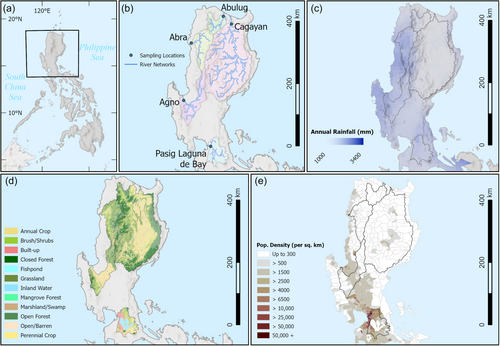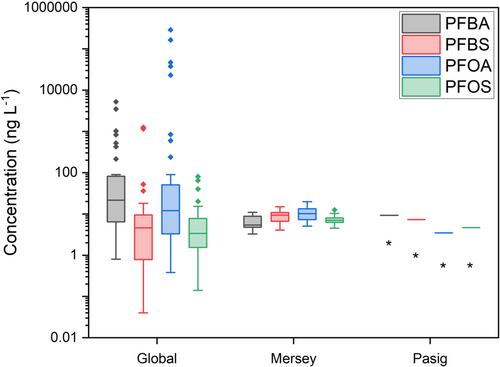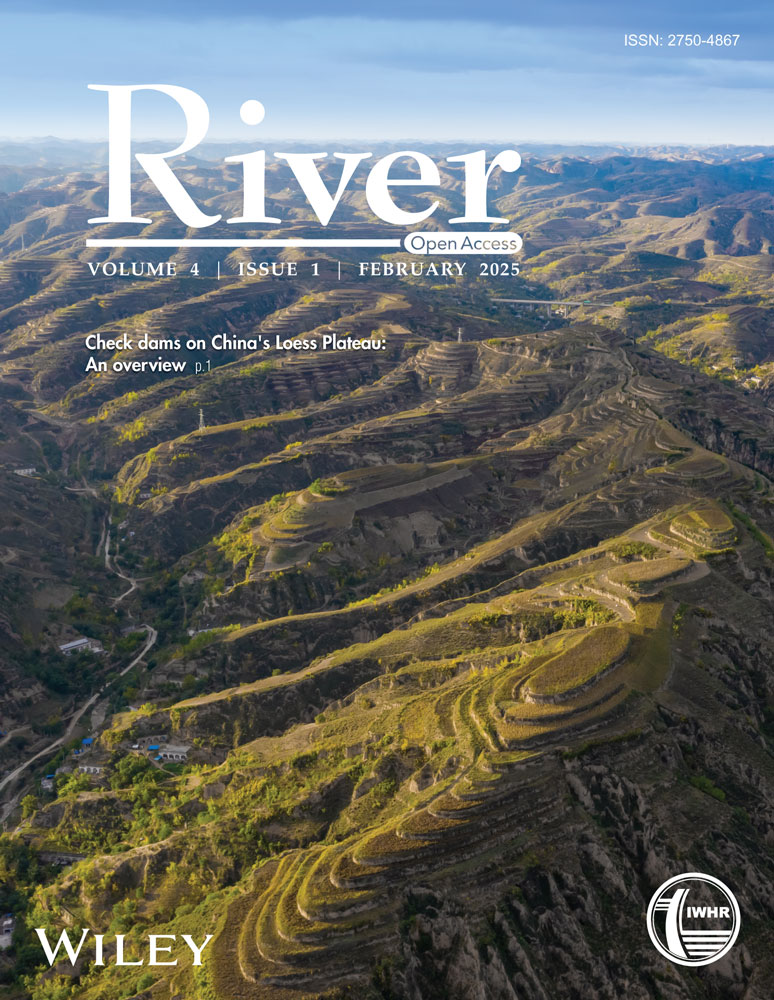Forever but not everywhere? Unexpected non-detection of per- and polyfluoroalkyl substances (PFAS) in major Philippines rivers
Abstract
Recent studies suggest per- and polyfluoroalkyl substances (PFAS) are ubiquitous in rivers worldwide. In the Asia-Pacific region, the frequency of PFAS detection in rivers is increasing. However, the overwhelming majority of studies and data represent high population and urbanized river catchments. In this study, we investigate PFAS occurrence in major Philippines river systems characterized by both high and low population densities. In the Pasig Laguna de Bay River, which drains a major urban conurbation, we detected PFAS at concentrations typical of global rivers. Unexpectedly, we did not detect PFAS in river water or sediments in low population density river catchments, despite our instrument detection limits being lower than the vast majority of river concentrations reported worldwide. We hypothesize that septic tanks, as the dominant wastewater treatment practice in Philippines catchments, may control the release of PFAS into groundwater and rivers in the Philippines. However, no groundwater PFAS data currently exist to validate this supposition. More broadly, our findings highlight the need for more representative PFAS sampling and analysis in rivers to more accurately represent regional and global detection frequencies and trends.
1 INTRODUCTION
Per- and poly-fluoroalkyl substances (PFAS), commonly termed “forever chemicals,” are a group of more than 14,000 chemicals (U.S. EPA, 2022) first manufactured in the 1940s and now detected in environments, wildlife, and humans worldwide (Evich et al., 2022; Ng et al., 2021). The oil- and water-repellent characteristics of PFAS, as well as their high thermal stability, have led to widespread applications in industry (e.g., polymer manufacture, surfactants, electronics) and in everyday consumer products (e.g., cookware, food packaging, personal care products, and textiles) (Glüge et al., 2020). The critical concern with PFAS is toxicity to humans and wildlife (Cathey et al., 2023; Grandjean et al., 2023; Pitter et al., 2020; Sheng et al., 2018; van Gerwen et al., 2023; Zhang et al., 2021), which is exacerbated by their extreme persistence (100 s to 1000 s of years) and long-range transport in the environment (Cousins et al., 2022).
Much research has focused on PFAS occurrence in rivers given their importance as sources of water (drinking and irrigation) and food (fish, shellfish, and plants), and because rivers and their catchment drainage processes control the transport of chemical compounds including PFAS from source areas to sensitive receptors, and ultimately to the oceans (Byrne et al., 2024). A recent synthesis of global surface and groundwater data (n = >45,900 samples) published in the journal Nature Geoscience (Ackerman Grunfeld et al., 2024) concluded that PFAS are pervasive in surface water and groundwater worldwide. However, almost all of these samples represent urbanized and densely populated river catchments, and postindustrial and agricultural landscapes in the Global North. In the Asia-Pacific region, PFAS detection in environmental matrices (air, soil, sediment, water) is reported to be increasing (Baluyot et al., 2021; Kurwadkar et al., 2022; UNEP, 2017). However, sample points are typically focused on rivers with high population densities, leading to poor data coverage, especially in tropical river catchments with low population densities.
The Philippines (Figure 1) exemplifies many Asia-Pacific nations experiencing rapid urbanization and population growth. In the Second Global Monitoring Report on Persistent Organic Pollutants (UNEP, 2017), the Stockholm Convention reported widespread PFAS contamination in rivers in the Asia-Pacific region (UNEP, 2017). However, in the Philippines, PFAS data are limited to one surface water body supplying drinking water to an urban conurbation (Metro Manila) (Guardian et al., 2020; Sevilla-Nastor et al., 2022). There exists no data on PFAS occurrence in any other Philippines surface waters, including rivers. Yet, representative sampling of PFAS occurrence in Philippines rivers is critically important as approximately 36% of rivers are utilized for public water supply (The World Bank Group, 2003). In this Perspective, we present preliminary findings and interpretations from the first regional-scale assessment of PFAS occurrence in major Philippines rivers.

2 METHODOLOGY
2.1 Study location
Our investigation focussed on five of the 18 major Philippines catchments classified by the National Water Resources Council based on their size (i.e., catchments with a land area greater than 1400 km2) and importance for water supply and biodiversity (Figure 1; Tabios, 2020). The study catchments are located in the island of Luzon, namely: the Abra River Basin, Agno River Basin, Apayao-Abulug River Basin, Cagayan River Basin, and Pasig-Laguna de Bay River Basin. Catchment areas range from 4000 to 27,500 km2 and the Pasig-Laguna de Bay catchment has a large urban extent (22.2%) and high population density (3295/km2) (Table 1), compared to the other four catchments (urban extent: 1.1% to 4.3%; population density: 136 to 235/km2).
| Catchment | Sample location | Sample ID | Population (thousands) | Area (km2)a | Pop. density (/km2)b | Average annual rainfall in 2021 (mm yr−1)c | Urban extent (%)d |
|---|---|---|---|---|---|---|---|
| Apayao-Abulog, Philippines | 18.201846° N 121.252458° E |
L-N3-WAT-R1 L-N3-WAT-R2 L-N3-WAT-BL |
554 | 4071 | 136 | 1936 | 1.2 |
| Abra, Philippines | 17.333308° N 120.273837° E |
L-N4-WAT-R1 L-N4-WAT-R2 L-N4-WAT-BL |
669 | 4919 | 136 | 2727 | 1.1 |
| Cagayan, Philippines | 18.072064° N 121.402073° E |
L-N2-WAT-R1 L-N2-WAT-R2 L-N2-WAT-BL |
4271 | 27558 | 155 | 1870 | 2.1 |
| Agno, Philippines | 15.532796° N 120.151319° E |
L-N1-WAT-R1 L-N1-WAT-R2 L-N1-WAT-BL L-N1-SED-FP L-N1-SED-SUR L-N1-SED-SUB |
1452 | 6179 | 235 | 2602 | 4.3 |
| Pasig-Laguna de Bay, Philippines | 14.335474° N 121.042326° E |
L-N5-WAT L-N5-WAT-BL |
13,526 | 4105 | 3295 | 2445 | 22.2 |
- Note: Key for samples: L = Luzon; N1-5 = river catchment; WAT = water sample; SED = sediment sample; R1-2 = replicate samples; BL = blank sample; FP = floodplain sediment; SUR = river channel surface sediment; SUB = river channel subsurface sediment.
- a Philippines data was obtained from Boothroyd et al. (2021).
- b River Basin Control Authority (2014) and Philippine Statistics Authority (2023).
- c Huffman et al. (2014).
- d NAMRIA (2021).
2.2 Sampling methods
A summary of samples collected and catchment characteristics is presented in Table 1. In each catchment, two river water samples (replicates) were collected near the catchment outlet using 250 mL high-density polyethylene (HDPE) bottles, as recommended by U.S. EPA Method 1633 to minimize potential contamination from sample bottles (U.S. EPA, 2024). Sampling was conducted just below the water surface, in the thalweg, and upstream of each tidal limit. In the Agno catchment, three sediment samples were also collected. One sample was collected from sediment deposited on the floodplain and interpreted to be from a recent high flow event. A second sample was collected from the surface of a geomorphologically active bar (1 cm depth), and a third sample was collected from the subsurface beneath the bar (20 cm depth). Five subsamples were retrieved from each sample location using a stainless-steel trowel. PFAS-free de-ionized water field blanks were also collected in each catchment to ensure that collection procedures and sample storage did not contaminate the samples. All samples were stored in fridges (at 4°C) and transported in cool boxes before analysis in the United Kingdom (UK).
2.3 Sample extraction and analysis
A detailed description of laboratory analytical procedures is provided in the supporting information. Briefly, water and sediment samples were extracted in a commercial laboratory (ALS Laboratories (UK) Ltd) using accredited methods TM337 (ALS Laboratories Ltd, 2022a) and TM338 (ALS Laboratories Ltd, 2022b) for water and sediment samples, respectively. Samples were spiked with isotopically labeled standards and then extracted by solid-phase extraction (SPE). Samples were then analyzed for 50 and 22 PFAS compounds in water and sediment (Table S1 and Table S2), respectively, using isotope dilution high performance liquid chromatography-tandem mass spectrometry (HPLC-MS/MS). The limits of detection (LOD) ranged from 0.65 ng L−1 PFOA to 10 ng L−1 EtFOSE in river water and 1 ng g−1 PFOA to 20 ng g−1 5:3 FTCA in river sediment. No contamination of field or laboratory blanks was detected.
3 ANALYSIS
Eight PFAS out of the 50 targeted compounds were detected in river water in the Pasig-Laguna de Bay River which flows through Metro Manila. The compounds detected (range = 1.49 to 9.28 ng L−1) were 6:2-fluorotelomer sulfonic acid (6:2 FTS), perfluorohexanoic acid (PFHxA), perfluoroheptanoic acid (PFHpA), perfluorooctane sulfonic acid (PFOS), perfluorooctanoic acid (PFOA), perfluorohexanesulfonic acid (PFHxS), perfluorobutanoic acid (PFBA), and perfluorobutane sulfonic acid (PFBS) (Table S1). To aid interpretation, we draw a comparison of four PFAS (PFBA, PBFS, PFOA, PFOS) detected in the Pasig Laguna de Bay River with data from the River Mersey, UK (Byrne et al., 2024), which has a similar catchment area (4680 km2) and high population density (1068/km2), and a synthesis of global surface water data presented by Calore et al. (2023). Concentrations observed in the Pasig Laguna de Bay River (Figure 2, Table S3) are broadly similar to median concentrations from the global (Calore et al., 2023) and high population density (Byrne et al., 2024) datasets. The range of concentrations in the global data set is considerable and demonstrates large variability in surface water concentrations in rivers worldwide.

Unexpectedly, PFAS were not detected (LODs = 0.65 to 2 ng L−1) in river water in the Abra, Apayao-Abulog, Agno, and Cagayan catchments, and no PFAS were detected in the sediments of the Agno (LODs = 1 to 20 ng g−1). Importantly, LODs in the present study are lower than 84% (PFBS) to 97% (PFOA) of the surface water concentrations reported by Calore et al. (2023) (Table S3), indicating PFAS are either not present in these rivers or at undetectable concentrations. This apparent absence of PFAS in major Philippine rivers (water and sediments) outside of Metro Manila is surprising given the well-documented global spread of these compounds (Ackerman Grunfeld et al., 2024; Cousins et al., 2022) and the increased detection of PFAS in environmental matrices in the Asia-Pacific Region (Kurwadkar et al., 2022). We offer three hypotheses to explore our findings.
3.1 PFAS transport in the Philippines catchments is constrained by connectivity and wastewater management practices
Effluents (treated and untreated) from sewage treatment plants (STPs) are one of the main sources of PFAS to rivers worldwide and an efficient transport pathway for PFAS source areas to rivers (Calore et al., 2023; Comber et al., 2020). In our study, we identified 55 STPs in the Pasig Laguna De Bay catchment but there are no STPs in the Agno, Abra, Cagayan, and Apayao-Abulog catchments as far as we are aware (NEDA (2021); Table S4). Although the population density of these four catchments is low, they still have large total populations (Table 1) served primarily by septic tanks (more than 70% of households in the Philippines are served by septic tanks) (World Bank and Australian Aid, 2013). Septic tanks are an important source of PFAS to groundwater and the unsaturated (vadose) zone between soils and groundwater can accumulate large stores of PFAS from septic tanks (Schaider et al., 2016; Silver et al., 2023). Release of this PFAS into groundwater might not occur for decades to centuries, with the hydraulic time scale of transport to rivers depending on the transmissivity of the aquifer (Ascott et al., 2017). In theory, PFAS-contaminated groundwater may not yet have reached some major river systems in Luzon. It follows that at some point in the future PFAS-contaminated groundwater may ‘breakthrough’ and impact river water quality, as is happening with nitrate in many countries where intensive use of fertilizers in the past has caused leaching to groundwater over decades and relatively slow transport to rivers (Abascal et al., 2022; Byrne et al., 2014).
3.2 River catchment population density and urban extent are important controls on the occurrence of PFAS in rivers
In our study, PFAS were only detected in the Pasig River (Metro Manila). This river catchment has an average population density of 3295 persons per km2 (range = ~1000 to >40,000 persons per km2) and an urban extent of 22.2% (Figure 1 and Table 1). In contrast, the Apayao-Abulog, Abra, Cagayan, and Agno catchments have average population densities ranging from 136 to 235 persons per km2 and urban extents ranging from 1% to 4% (Figure 1 and Table 1). It is worth hypothesizing, therefore, that the non-detection of PFAS in four of our five study catchments in Luzon may be explained by their low population densities and urban extent. In the USA and Sweden, recent national-scale studies found people living in urban areas have higher probabilities of PFAS exposure in drinking water and soil, respectively (Smalling et al., 2023; Sörengård et al., 2022). Of course, the presence of a centralized sewerage system in Metro Manila may serve to efficiently route PFAS from catchment source areas to the river, as described previously. However, only about 15% of households in Manila are connected to a sewerage system and, importantly, industrial and commercial activities are also likely to be sources of PFAS to the Pasig River (Jalilov, 2018). Furthermore, although the population density of catchments outside of Manila is low, the total population of these catchments is still large (Table 1) with clusters of high population centers served primarily by septic tanks.
3.3 PFAS are present in Philippines rivers, but not detectable with our analytical approach
It is surprising that we did not detect PFAS in river water and sediment samples outside of Metro Manila. Our sampling campaign took place during the dry season in Luzon (November to April) when we expected solute and chemical concentrations in river water to be highest due to reduced dilution. If pollution events were transient, for example, associated with rainfall, we would expect to detect PFAS in river sediments which are more resilient to seasonal hydrological and biogeochemical processes that drive variability in river water concentrations. Although our sample sites were situated close to the catchment outlets, PFAS entering the rivers from upstream sources (e.g., groundwater or runoff from agricultural land) may have undergone dilution within the river channel, causing non-detection at our sample sites. However, the LODs for PFAS in our study were well below typical river and surface water concentrations (e.g., Ackerman Grunfeld et al., 2024; Byrne et al., 2024; Calore et al., 2023; Figure 2), so if PFAS were present, we would have expected to detect them. Our analytical approach utilized a targeted method to quantify concentrations of a limited number of PFAS compounds (50 in water and 20 in sediment samples). As a result, it is possible that other PFAS compounds were missed and suspect screening using nontargeted or total PFAS analysis (e.g., TOP Assay) may be preferable to confirm the presence or absence of PFAS in rivers (Ateia et al., 2023).
4 CONCLUSIONS
In this Perspective, we report no detectable PFAS (<0.65 to <2 ng L−1 in water and <1 to <20 ng g−1 in sediment) in four of our five study rivers in the Philippines. This is despite concern that PFAS are ubiquitous in surface water worldwide and detection frequencies are increasing, in particular in the Asia-Pacific region. If we assume PFAS are ubiquitous in rivers, then where are they? We hypothesize that the delayed and dispersed release of PFAS into groundwater via septic tanks in low population density river catchments might explain this result. Unfortunately, as far as we are aware, no data exists on PFAS occurrence in groundwater in the Philippines. Our findings highlight the need for more representative PFAS sampling and analysis in Philippines river catchments, and more broadly throughout the Asia-Pacific region. Furthermore, in river catchments where wastewater management is dominated by septic tanks, we suggest that groundwater should be tested for PFAS, preferably using both targeted and nontargeted analytical methods.
ACKNOWLEDGEMENTS
The authors are grateful to the Natural Environment Research Council (NERC) and Department of Science and Technology - Philippine Council for Industry, Energy and Emerging Technology Research and Development (DOST-PCIEERD) project NE/W006871/1 for funding field logistics. We thank Craig MacDonnell at the University of Glasgow for assistance with map production.
ETHICS STATEMENT
None declared.
Open Research
DATA AVAILABILITY STATEMENT
The data used in this study is openly available.




